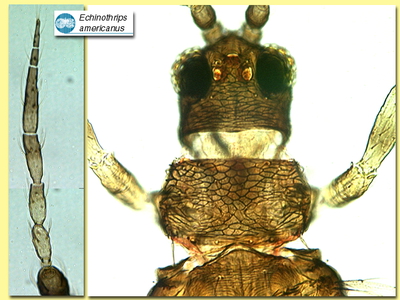Figures
Fig. 1 Antenna, head and pronotum
Fig. 2 Head, thorax and abdomen
Fig. 3 Fore and hind wing
Fig. 4 Tergite IV (left) and sternites with pore plates (male)
Species
Echinothrips americanus Priesner
Biology
This south east Asian species is sometimes common on orchid plants and orchid flowers, but seems to have been largely replaced by Thrips palmi on commercially grown orchids since the 1980's.
Distribution
Originally from North America, but now established in greenhouses in Europe. This species must be considered to be a potential invader of Australia. It has recently been found in large numbers on Eichhornia in Thailand.
Recognition
Small dark brown thrips with all tarsi and apices of tibiae yellow, antennal segments III & IV yellow, forewing dark with base pale. Antennae 8-segmented, terminal segments slender, sense cones on III & IV simple. Head projecting slightly in front of eyes, dorsal surface irregularly reticulate. Pronotum reticulate, with two pairs of long dark posteroangular setae. Metanotum reticulate, except anteromedially. Forewing setal rows on costa and first vein complete, setae long, dark and capitate; second vein without setae. Tergites with one pair of setae close together medially, lateral areas with sculpture lines bearing microtrichia. Sternites often slightly emarginate medially. Male sternites with numerous small glandular areas.
Related species
Currently seven species are placed in this genus, but the other six have restricted distributions and restricted host ranges in the New World. Although parts of the body surface are reticulate as in panchaetothripines, the long capitate setae distinguish this species from members of that group.





